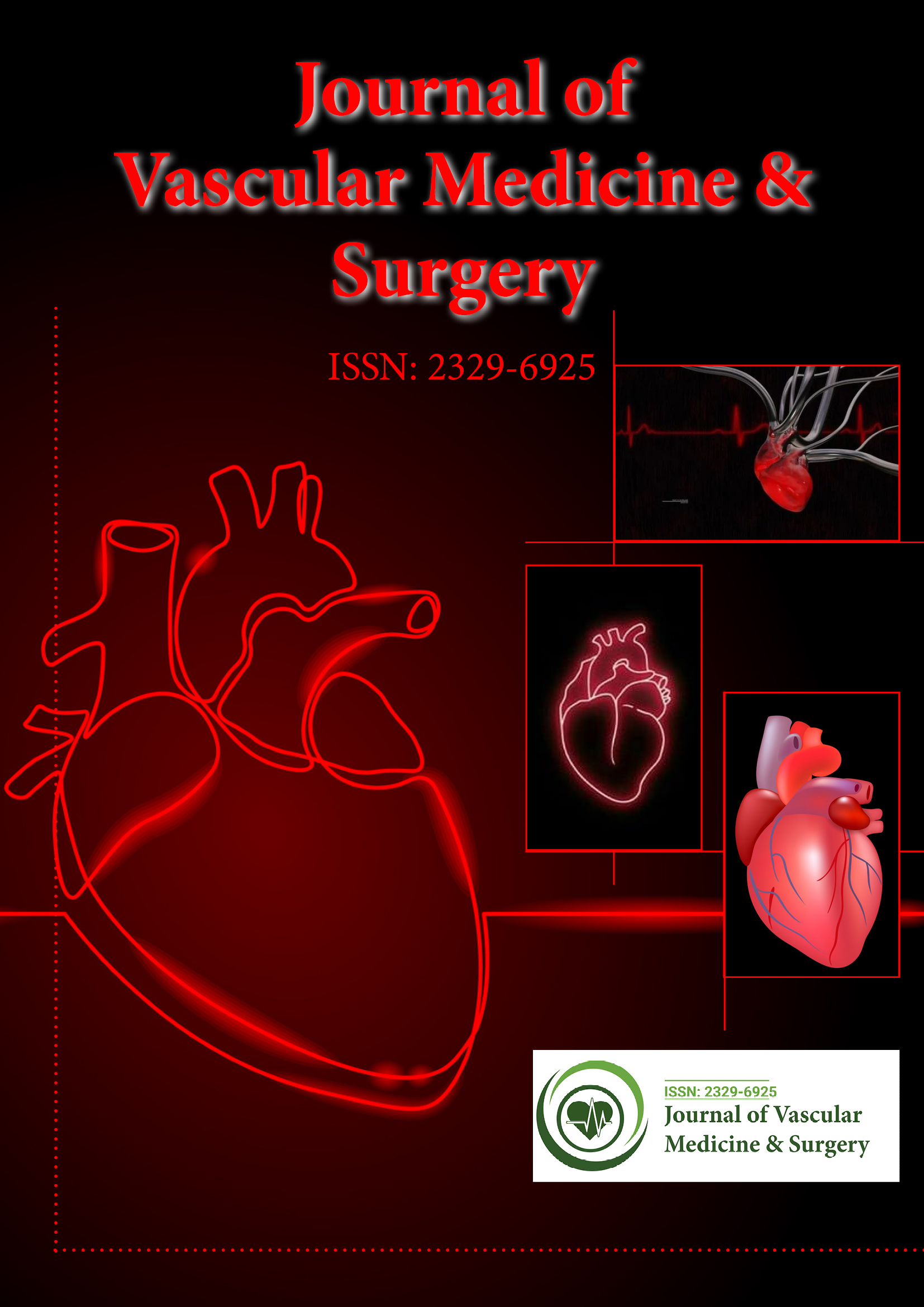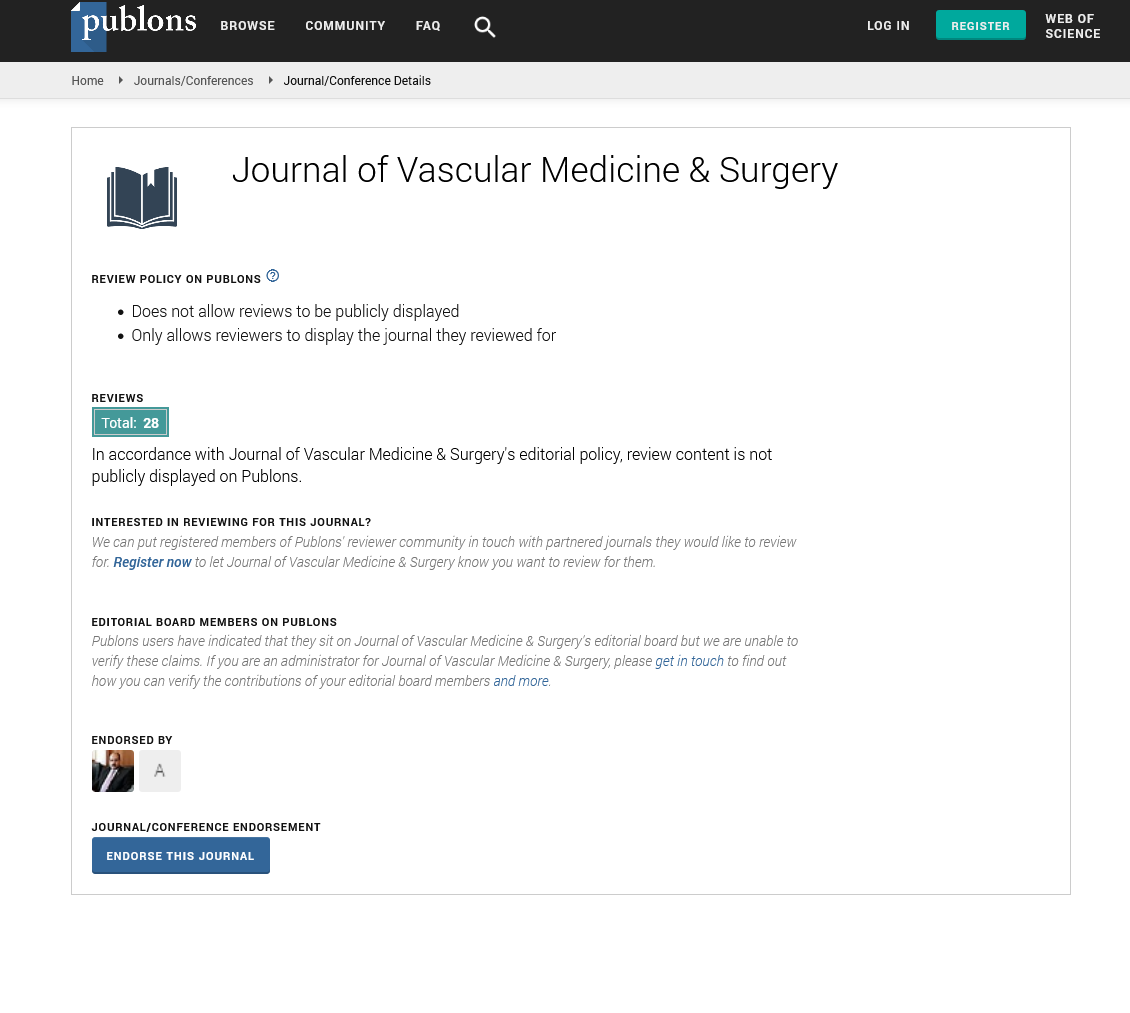Indexed In
- Open J Gate
- Academic Keys
- RefSeek
- Hamdard University
- EBSCO A-Z
- OCLC- WorldCat
- Publons
- Euro Pub
- Google Scholar
- SHERPA ROMEO
Useful Links
Share This Page
Journal Flyer

Open Access Journals
- Agri and Aquaculture
- Biochemistry
- Bioinformatics & Systems Biology
- Business & Management
- Chemistry
- Clinical Sciences
- Engineering
- Food & Nutrition
- General Science
- Genetics & Molecular Biology
- Immunology & Microbiology
- Medical Sciences
- Neuroscience & Psychology
- Nursing & Health Care
- Pharmaceutical Sciences
Perspective - (2024) Volume 12, Issue 4
Diagnostic Approaches of Managing and Preventing Varicose Veins from Cosmetic Concern to Serious Complication
Jones Jianna*Received: 24-Jun-2024, Manuscript No. JVMS-24-26698; Editor assigned: 27-Jun-2024, Pre QC No. JVMS-24-26698 (PQ); Reviewed: 11-Jul-2024, QC No. JVMS-24-26698; Revised: 18-Jul-2024, Manuscript No. JVMS-24-26698 (R); Published: 25-Jul-2024, DOI: 10.35248/2329-6925.24.12.564
Description
Veins that are twisted and swollen, usually found on the legs and feet which are signs of a common vascular disorder called varicose veins. They sometimes result in more serious health complications, even though they are frequently thought of as cosmetic concerns. The weakening or deterioration of venous valves results in varicose veins. These one-way valves guarantee that blood flows in the direction of the heart under typical conditions. When they don't work properly, blood might pool in the veins and flow backward, making them expand. The diagnosis of varicose veins is usually made by physical examination. However, a physician could advise additional testing like a Venogram and Doppler Ultrasound to identify the precise cause and extent of the ailment. Varicose veins can be managed with a variety of treatments, from lifestyle modifications to medical operations. Symptoms can be reduced and new varicose veins can be avoided by increasing muscle tone and circulation. Regular exercise, weight loss, leg elevation, and avoiding extended standing or sitting are some of the suggestions made. With sclerosing therapy, a solution is injected straight into the vein, causing it to narrow and damage. After treatment, the vein will disappear in a few weeks. An enlarged vein is treated with a catheter, and the vein is sealed with heat from a laser or radiofrequency source.
Smaller varicose veins can be removed using an ambulatory phlebectomy by making a series of microscopic skin damage. Advanced ulcer instances are treated with endoscopic vein surgery. To examine and heal veins, a tiny camera is placed into the leg. Even though they are sometimes considered as a cosmetic concern, varicose veins can cause severe discomfort and even consequences if they are not addressed. Effective management of this condition can be achieved by people having a thorough understanding of its causes, symptoms, risk factors, and available treatments. Varicose veins can be managed with a mix of lifestyle modifications and medical treatments, which will improve the quality of life for those who have them. It might not always be able to prevent varicose veins, particularly if we have a strong genetic propensity. However, implementing specific lifestyle practices can considerably lower the risk of varicose veins arising and decelerate their advancement. The following are a few methods to help avoid varicose veins:
Exercise regularly
Frequent exercise helps improve circulation overall and muscle tone, both of which helps to prevent varicose veins. Exercises like cycling, swimming, and walking are particularly beneficial. During exercise, the calf muscles improve their ability to pump blood back up into the heart.
Maintain a healthy weight
Being overweight puts more strain on the blood vessels, especially in the legs. Retaining a healthy weight can help avoid varicose veins by lowering this pressure. Constipation and water retention are two more conditions that can be avoided by eating a balanced diet low in salt and high in fiber. These conditions can also lead to varicose veins.
Elevate the legs
Circulation can be improved by uplifting the legs for a few minutes at a time, or several times a day. By raising the legs over the heart, one can decrease the pressure on the leg veins, which helps blood return to the heart.
Avoid prolonged standing or sitting
Standing or sitting for a long period of time might reduce blood flow to the legs. Try to take frequent breaks to move around if the job demands one to stand or sit for extended amounts of time. We can maintain blood flow by bending the legs, changing diet, or going for quick walks.
Wear compression stockings
Consistent pressure applied to the legs by compression clothing facilitates more effective blood flow through the veins and muscles. Those who must stand for extended periods of time or are susceptible to varicose veins will find them especially helpful. We can select the perfect sort of compression stockings by speaking with a healthcare professional about the levels of strength and durations involved.
Avoid tight clothing
Tight clothing can impede blood flow and exacerbate varicose veins, particularly around the waist, legs, and hip area. Choose clothing that fits loosely so that it doesn't restrict any area of the human body.
Maintaining the skin is critical, particularly if we have varicose veins. Preventing ulcers and other issues can be achieved by maintaining hydrated skin. Additionally, keep the skin safe from the sun's rays and steer clear of traumas as these can worsen vein issues. Staying well-hydrated helps to maintain healthy circulation and prevents blood from becoming too thick, which can strain the veins. Habituate to drink plenty of water throughout the day. While it may not be possible to completely prevent varicose veins, adopting these preventive measures can significantly reduce the risk and slow their progression. We can lower the risk of acquiring varicose veins and better maintain the health of the veins by staying active.
Citation: Jianna J (2024) Diagnostic Approaches of Managing and Preventing Varicose Veins from Cosmetic Concern to Serious Complication. J Vasc Surg. 12:564.
Copyright: © 2024 Jianna J. This is an open-access article distributed under the terms of the Creative Commons Attribution License, which permits unrestricted use, distribution, and reproduction in any medium, provided the original author and source are credited.

